 Facebook
Facebook
 X
X
 Instagram
Instagram
 TikTok
TikTok
 Youtube
Youtube
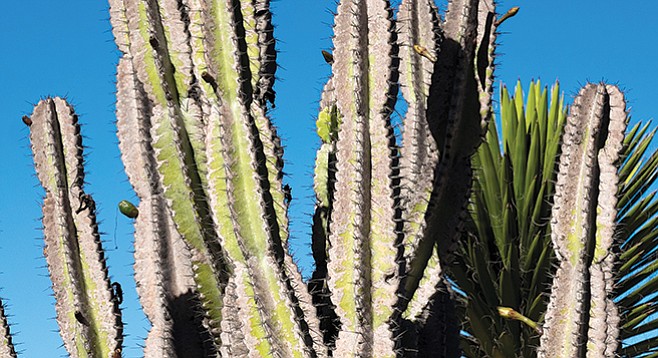
“Here? I do the trimming, the fertilizing, watering, and so on. This client, a commercial storefront on Herschel in La Jolla Village, wanted to save on watering, so they had me take out all the Japanese boxwood,” a compact shrub that used to run the length of the building. In its place now is an uneven bed of pea gravel. Nicholas Poulsen, 27, a self-employed gardener, estimates that before the drought, his annual income was somewhere in the neighborhood of $70,000 per year, gross.
“It’s dropped by about 20 percent,” he says. “Yeah. The drought took out a lot of my business.”
Poulsen, in clean work pants, a blue pullover, and a straw hat, says he brings home a little more than $50,000 a year now, and he struggles to earn that. He and his wife rent an apartment in the UTC area. A graduate of the landscape program at Mesa College, he hopes one day to become a landscape architect. He smiles frequently, says he’s been in the business since his teen years.
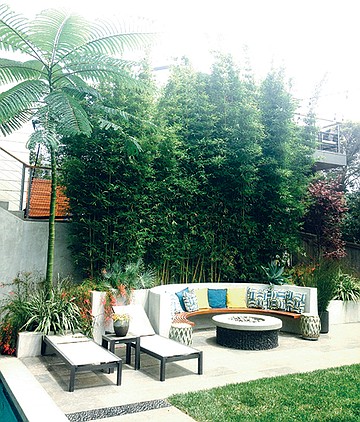
Last year, in response to California’s ongoing drought, governor Jerry Brown declared a state of emergency. The mandate demanded a 25 percent reduction in water use. One statewide goal was to nix upward of 50 million square feet of lawn. For a time, cash incentives were offered to home and property owners to go artificial or re-landscape with drought tolerance in mind. According to the Centre for Landscape and Urban Horticulture, residential lawns in California represent around 7 percent of the total water used. (That pales in comparison to the 77 percent used by agriculture, but still, that 7 percent is the second largest use of water in a state where the average person uses 181 gallons of water daily.) Then, there were the “water police.” Some local municipalities enforced restrictions on outdoor water use. Responses were varied. While some homeowners ignored the mandate, others shut down watering entirely and allowed their once-cherished little patches of green to go to dirt. In the middle of all of this transition? The neighborhood gardener. The lawn cutters of the past are facing a changing urban landscape, one that in some cases is all but disappearing. How are they staying alive?
Poulsen shifts the load under the hard shell on the back of his 2005 SR5 pickup to get at his cutting and trimming tools. First, the weed-whacker. “I come to this client every two weeks,” he explains, firing up the tiny gas engine and advancing toward the two parking strips. Next comes the lawn mower, a red Toro he says he paid $2000 for new. “It’s built to last. See these tires? They cost 50 bucks each to replace. That’s $200 just in tires.”
The Toro conks out twice while Poulson cuts the grass.
“A lot of clients are converting to synthetic lawns. It costs from $7 to $10 installed. Yeah, the price has come way down because of all the competition. Before the drought, it was laughed at. And a lot of communities wouldn’t let you install it. It’s not a real lawn. Hey — remember those guys who used to come along and paint your dead grass green? I’d never do that to someone’s lawn.”
Poulsen’s next job is six miles away. He repacks his equipment into the back of his truck and heads uphill out of the shielding overcast of La Jolla toward Clairemont.

“It’s really a great time for the yardscape business.” Ron Bocian, 48, has been in the business since he was 18. He is a landscape designer based in San Diego but with clients afar. “I offer horticultural services. And more than ever I am hired as a consultant to create a plan for transitioning to a xeriscape.”
As we near the Balboa Park xeriscape — a non-, or near-nonirrigated landscape — along the east side of Park Boulevard, he alternates between pointing out plants and engaging in an email exchange with a client — in this case, Jim Mora, the head football coach at UCLA.
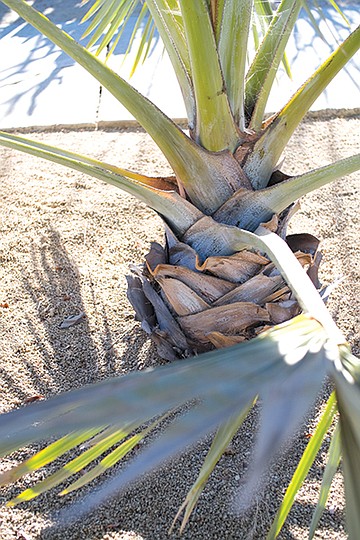
“That’s a Bismarckia nobilis,” Bocian says, pointing in the direction of a ground-hugging rotund blue-ish fan palm he says is originally from Madagascar. “I use them as accents all the time. That bottle tree’s nice, too,” Bocian says, shifting his gaze to a tree with tight little olive-green leaves that is otherwise mostly trunk. “They’re from what, Western Australia? I use them, too,” he says. “One that size? Probably cost you close to $10,000. And then, there’s the cost of installation.”
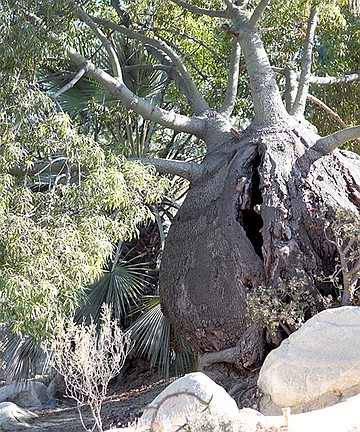
Bocian, in white T-shirt and board shorts, says of these hot and arid times, “Now that people have cut back on their watering, suddenly they see all this dirt where there used to be a lawn. What do they do with it?” He points out a rock-rimmed patch of dust, succulents, barrel cactus, and other Dr. Seuss-ian–looking plant life. Clients have him install flora that can thrive, he says, on rainfall alone.
“I always try to get my clients to get rid of 20 percent of their existing lawn anyway,” he says. “I think it was Blue San Diego that for a while was giving good rebates to do just that.”
At what cost?
“To tear out, say, 1200 square feet of lawn?” He says that’s about average size for suburbia. “I’d say $2500. That’s a lot of work.”
Why a grass lawn in the first place?
“I don’t know. Maybe it’s all a part of the American Dream,” Bocian theorizes, “that little patch of grass. I did a garden out in Palm Springs once, and they wanted a lawn. I said, ‘Man, you can’t be serious.’”
“Originally, this was all grass.” Poulsen parks his truck in the driveway of a sunbaked Kennedy-era home in north Clairemont off of Genesee Avenue. “And, there was a giant fish pond.” Not anymore. The pond’s been filled in and planted over, and the yard is now gravel, shrubbery, and trees. The homeowner, a widow of 86, has been expecting him.
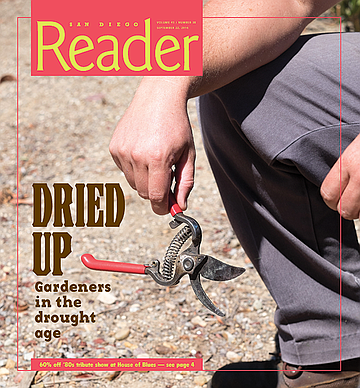
“It’s hard to find a gardener who will take care of a yard like mine,” she says. “Most of them just want to blow and go.” She shows photos of the pond in its prime while Poulsen chops weeds and rakes. The homeowner’s been burned by a few gardeners in the past, and she wants to talk about it.
“These Vietnamese guys — they charged me for an hour of work, but they got the job done in ten minutes, and then they were gone.”
Poulsen delights in showing me the drought-tolerant plants that now occupy the large back yard. “This here is a lemonade bush. It’s native to San Diego.”
“I didn’t plant it,” the homeowner says. “The birds just crapped, and there it is.”
Next, Poulsen indicates rows of tightly trimmed bunched shrubs he says are manzanita.
“You never water a manzanita,” she says. “Watering a manzanita in the summer will kill it. They come from dry country.”
Poulsen smiles. “This is elephant food.” He directs my attention to a lime-green succulent cluster. “It’s from Africa. The elephants eat this stuff.”

The homeowner wants Poulsen to dig out some excess firestick plant, which is toxic. “You better have gloves on.” He does. “Good.” She expresses gratitude at not having to maintain the ponds any longer. She shares a few more gardener war stories, micro-manages Poulsen a bit more, then heads back temporarily into the cooler shade of the house.
“When I started here,” Poulsen says, “the weeds were this high.” He indicates mid-waist wild mustard with a gloved hand. The homeowner materializes with a photo showing waist-high weed thickets. She blames their presence on the last gardener. “He put in adobe walkways,” she explains. “And they were fertile ground for the weeds.” She had the adobe paved over with red brick. She has lost track of the thousands of dollars she has spent to convert from waterscape to xeriscape. Even with a thin breeze coming up the slope from the 52 freeway, the temperature in the yard is pushing into the triple digits.
“Some weeks, I work between 30 and 50 hours,” Poulsen says. “In the summer, my hours are longer. Why? Because the days are longer. There’s more daylight. In the landscape world, you work around the sun. Yeah, I make less during the winter.”

“Americans spend $76 billion each year on lawn care. Eighty percent of suburbia has lawns.” Armed with those statistics, Jeremy Yamaguchi started his Rancho Bernardo–based Lawn Love with $3 million of venture capital two years ago — in the middle of California’s drought. He describes his company as “the Uber of lawn care.” He says that the platform now services 38 cities in 28 states. Pre-screened gardeners get connected to a pipeline of paying customers via an app, just like the taxi services.
“We haven’t seen a profound impact from the drought,” Yamaguchi explains, “because we launched in a drought.” He says compared to other regions of operation, California is Lawn Love’s biggest market. “New homes,” he explains, “are still being built with grass lawns. And another indicator of market strength is that the number of conversions [to xeriscapes] is on the rise.”
Yamaguchi scoffs at the idea of artificial turf. “That’s like asking a Michelin chef what he thinks of Chef Boyardee.” He says he is surprised nonetheless at the market penetration of the product. “The future probably is going to be synthetics, but then again, maybe not. We have an intangible connection to nature. And plastic lawns don’t give off oxygen.” He says they charge $2 per square foot to put down sod, which does give off oxygen. He admits that there is a psychological benefit to green, even if plastic. “You can’t use a xeriscape. You can’t play football on it. As a culture, we have an attachment to a lawn, even if it’s fake.”

“My guys are doing a clean-up over on Central Avenue. We got six guys right now, working full-time.” Cesar Calderon, a former grocery produce manager, has been in the yard-care business for 11 years. He is 33. On the day we meet in his office, which is really a converted storage container behind a storefront on the north side of University Avenue, a block west of College, a tiny air conditioner struggles to keep the midday heat at bay.
The drought?
“It’s been good, and it’s been bad. Bad, because we lose maintenance accounts.” By that, he means the weekly lawn cut-and-trim customer. “Sixty percent of those are gone.” Yes, he says, those customers got rid of their lawns.
“We’d do four days each week of just maintenance work. Now, it’s down to two days a week.” When water got too expensive and his customers changed their minds about gardening, that’s when Calderon switched to the installation of xeriscapes. “And when the city had those rebate programs going,” he says, “we got tons of that work.” He thinks his business will gross close to $1 million this year, give or take. And that’s up from last year. He plans to retire in a decade.

Nicholas Poulsen accidentally knocks over a yard gnome then rights it. It stands in a weedy thicket of water-starved ground vinery that encircles the foundation of a house on Landis Street in North Park. This job is a referral. “I get $20 from Lawn Love,” Poulsen says. “If I get it done in 30 minutes, I get 20 dollars. If it takes me an hour and a half, I still get that 20 dollars.” Which doesn’t seem like much money for the job at hand. “I’ll get done what I can in an hour. But the upside is that if I can get, say, five or more in this same area and go from one to the other, I can make a hundred bucks in a couple of hours.”
But this does not seem like the kind of neighborhood that has much use for gardening services. Four men walk out of an alley. One of them carries a dog. Six or eight crows worrying over something in the middle of the blacktop scatter. Most all lawns around here are gone to yellow stubble. Some homes have even less: sketchy rock gardens or patches of neglect and dried clay. You can count the number of shade trees along this street on one hand.

Poulsen explains that most landscape companies pay $15 per hour, plus overtime. “I wouldn’t have to pay for my gas or insurance either,” he says. On his own hook, and with jobs from Lawn Love, he covers all of the expenses. It’s starting to sound like by the end of this particular job, he will have netted closer to $10 per hour. Or maybe less. He says he would charge $45 per hour if he booked this job himself. Or any job, for that matter.
Poulsen carries liability insurance, and his work tools are insured as well. “It costs a lot to get started in this business. First, you’ll need a truck with a V8, in case you have to do some hauling.” He estimates he has invested somewhere in the neighborhood of $5000 in tools, including the mower and trimmers and leaf blowers that he says he has to replace every two to three years.
He fires up the weed-whacker. He chops, he pulls, he trims, and he whacks. And then, the leaf blower. Has the 20 percent income drop he’d mentioned caused by the drought caused Poulsen to make any lifestyle adjustments?
“Yeah,” he says. “Now I have to work on Saturdays. And Sundays. I’m always looking for extra work.”


“Here? I do the trimming, the fertilizing, watering, and so on. This client, a commercial storefront on Herschel in La Jolla Village, wanted to save on watering, so they had me take out all the Japanese boxwood,” a compact shrub that used to run the length of the building. In its place now is an uneven bed of pea gravel. Nicholas Poulsen, 27, a self-employed gardener, estimates that before the drought, his annual income was somewhere in the neighborhood of $70,000 per year, gross.
“It’s dropped by about 20 percent,” he says. “Yeah. The drought took out a lot of my business.”
Poulsen, in clean work pants, a blue pullover, and a straw hat, says he brings home a little more than $50,000 a year now, and he struggles to earn that. He and his wife rent an apartment in the UTC area. A graduate of the landscape program at Mesa College, he hopes one day to become a landscape architect. He smiles frequently, says he’s been in the business since his teen years.

Last year, in response to California’s ongoing drought, governor Jerry Brown declared a state of emergency. The mandate demanded a 25 percent reduction in water use. One statewide goal was to nix upward of 50 million square feet of lawn. For a time, cash incentives were offered to home and property owners to go artificial or re-landscape with drought tolerance in mind. According to the Centre for Landscape and Urban Horticulture, residential lawns in California represent around 7 percent of the total water used. (That pales in comparison to the 77 percent used by agriculture, but still, that 7 percent is the second largest use of water in a state where the average person uses 181 gallons of water daily.) Then, there were the “water police.” Some local municipalities enforced restrictions on outdoor water use. Responses were varied. While some homeowners ignored the mandate, others shut down watering entirely and allowed their once-cherished little patches of green to go to dirt. In the middle of all of this transition? The neighborhood gardener. The lawn cutters of the past are facing a changing urban landscape, one that in some cases is all but disappearing. How are they staying alive?
Poulsen shifts the load under the hard shell on the back of his 2005 SR5 pickup to get at his cutting and trimming tools. First, the weed-whacker. “I come to this client every two weeks,” he explains, firing up the tiny gas engine and advancing toward the two parking strips. Next comes the lawn mower, a red Toro he says he paid $2000 for new. “It’s built to last. See these tires? They cost 50 bucks each to replace. That’s $200 just in tires.”
The Toro conks out twice while Poulson cuts the grass.
“A lot of clients are converting to synthetic lawns. It costs from $7 to $10 installed. Yeah, the price has come way down because of all the competition. Before the drought, it was laughed at. And a lot of communities wouldn’t let you install it. It’s not a real lawn. Hey — remember those guys who used to come along and paint your dead grass green? I’d never do that to someone’s lawn.”
Poulsen’s next job is six miles away. He repacks his equipment into the back of his truck and heads uphill out of the shielding overcast of La Jolla toward Clairemont.

“It’s really a great time for the yardscape business.” Ron Bocian, 48, has been in the business since he was 18. He is a landscape designer based in San Diego but with clients afar. “I offer horticultural services. And more than ever I am hired as a consultant to create a plan for transitioning to a xeriscape.”
As we near the Balboa Park xeriscape — a non-, or near-nonirrigated landscape — along the east side of Park Boulevard, he alternates between pointing out plants and engaging in an email exchange with a client — in this case, Jim Mora, the head football coach at UCLA.

“That’s a Bismarckia nobilis,” Bocian says, pointing in the direction of a ground-hugging rotund blue-ish fan palm he says is originally from Madagascar. “I use them as accents all the time. That bottle tree’s nice, too,” Bocian says, shifting his gaze to a tree with tight little olive-green leaves that is otherwise mostly trunk. “They’re from what, Western Australia? I use them, too,” he says. “One that size? Probably cost you close to $10,000. And then, there’s the cost of installation.”

Bocian, in white T-shirt and board shorts, says of these hot and arid times, “Now that people have cut back on their watering, suddenly they see all this dirt where there used to be a lawn. What do they do with it?” He points out a rock-rimmed patch of dust, succulents, barrel cactus, and other Dr. Seuss-ian–looking plant life. Clients have him install flora that can thrive, he says, on rainfall alone.
“I always try to get my clients to get rid of 20 percent of their existing lawn anyway,” he says. “I think it was Blue San Diego that for a while was giving good rebates to do just that.”
At what cost?
“To tear out, say, 1200 square feet of lawn?” He says that’s about average size for suburbia. “I’d say $2500. That’s a lot of work.”
Why a grass lawn in the first place?
“I don’t know. Maybe it’s all a part of the American Dream,” Bocian theorizes, “that little patch of grass. I did a garden out in Palm Springs once, and they wanted a lawn. I said, ‘Man, you can’t be serious.’”
“Originally, this was all grass.” Poulsen parks his truck in the driveway of a sunbaked Kennedy-era home in north Clairemont off of Genesee Avenue. “And, there was a giant fish pond.” Not anymore. The pond’s been filled in and planted over, and the yard is now gravel, shrubbery, and trees. The homeowner, a widow of 86, has been expecting him.

“It’s hard to find a gardener who will take care of a yard like mine,” she says. “Most of them just want to blow and go.” She shows photos of the pond in its prime while Poulsen chops weeds and rakes. The homeowner’s been burned by a few gardeners in the past, and she wants to talk about it.
“These Vietnamese guys — they charged me for an hour of work, but they got the job done in ten minutes, and then they were gone.”
Poulsen delights in showing me the drought-tolerant plants that now occupy the large back yard. “This here is a lemonade bush. It’s native to San Diego.”
“I didn’t plant it,” the homeowner says. “The birds just crapped, and there it is.”
Next, Poulsen indicates rows of tightly trimmed bunched shrubs he says are manzanita.
“You never water a manzanita,” she says. “Watering a manzanita in the summer will kill it. They come from dry country.”
Poulsen smiles. “This is elephant food.” He directs my attention to a lime-green succulent cluster. “It’s from Africa. The elephants eat this stuff.”

The homeowner wants Poulsen to dig out some excess firestick plant, which is toxic. “You better have gloves on.” He does. “Good.” She expresses gratitude at not having to maintain the ponds any longer. She shares a few more gardener war stories, micro-manages Poulsen a bit more, then heads back temporarily into the cooler shade of the house.
“When I started here,” Poulsen says, “the weeds were this high.” He indicates mid-waist wild mustard with a gloved hand. The homeowner materializes with a photo showing waist-high weed thickets. She blames their presence on the last gardener. “He put in adobe walkways,” she explains. “And they were fertile ground for the weeds.” She had the adobe paved over with red brick. She has lost track of the thousands of dollars she has spent to convert from waterscape to xeriscape. Even with a thin breeze coming up the slope from the 52 freeway, the temperature in the yard is pushing into the triple digits.
“Some weeks, I work between 30 and 50 hours,” Poulsen says. “In the summer, my hours are longer. Why? Because the days are longer. There’s more daylight. In the landscape world, you work around the sun. Yeah, I make less during the winter.”

“Americans spend $76 billion each year on lawn care. Eighty percent of suburbia has lawns.” Armed with those statistics, Jeremy Yamaguchi started his Rancho Bernardo–based Lawn Love with $3 million of venture capital two years ago — in the middle of California’s drought. He describes his company as “the Uber of lawn care.” He says that the platform now services 38 cities in 28 states. Pre-screened gardeners get connected to a pipeline of paying customers via an app, just like the taxi services.
“We haven’t seen a profound impact from the drought,” Yamaguchi explains, “because we launched in a drought.” He says compared to other regions of operation, California is Lawn Love’s biggest market. “New homes,” he explains, “are still being built with grass lawns. And another indicator of market strength is that the number of conversions [to xeriscapes] is on the rise.”
Yamaguchi scoffs at the idea of artificial turf. “That’s like asking a Michelin chef what he thinks of Chef Boyardee.” He says he is surprised nonetheless at the market penetration of the product. “The future probably is going to be synthetics, but then again, maybe not. We have an intangible connection to nature. And plastic lawns don’t give off oxygen.” He says they charge $2 per square foot to put down sod, which does give off oxygen. He admits that there is a psychological benefit to green, even if plastic. “You can’t use a xeriscape. You can’t play football on it. As a culture, we have an attachment to a lawn, even if it’s fake.”

“My guys are doing a clean-up over on Central Avenue. We got six guys right now, working full-time.” Cesar Calderon, a former grocery produce manager, has been in the yard-care business for 11 years. He is 33. On the day we meet in his office, which is really a converted storage container behind a storefront on the north side of University Avenue, a block west of College, a tiny air conditioner struggles to keep the midday heat at bay.
The drought?
“It’s been good, and it’s been bad. Bad, because we lose maintenance accounts.” By that, he means the weekly lawn cut-and-trim customer. “Sixty percent of those are gone.” Yes, he says, those customers got rid of their lawns.
“We’d do four days each week of just maintenance work. Now, it’s down to two days a week.” When water got too expensive and his customers changed their minds about gardening, that’s when Calderon switched to the installation of xeriscapes. “And when the city had those rebate programs going,” he says, “we got tons of that work.” He thinks his business will gross close to $1 million this year, give or take. And that’s up from last year. He plans to retire in a decade.

Nicholas Poulsen accidentally knocks over a yard gnome then rights it. It stands in a weedy thicket of water-starved ground vinery that encircles the foundation of a house on Landis Street in North Park. This job is a referral. “I get $20 from Lawn Love,” Poulsen says. “If I get it done in 30 minutes, I get 20 dollars. If it takes me an hour and a half, I still get that 20 dollars.” Which doesn’t seem like much money for the job at hand. “I’ll get done what I can in an hour. But the upside is that if I can get, say, five or more in this same area and go from one to the other, I can make a hundred bucks in a couple of hours.”
But this does not seem like the kind of neighborhood that has much use for gardening services. Four men walk out of an alley. One of them carries a dog. Six or eight crows worrying over something in the middle of the blacktop scatter. Most all lawns around here are gone to yellow stubble. Some homes have even less: sketchy rock gardens or patches of neglect and dried clay. You can count the number of shade trees along this street on one hand.

Poulsen explains that most landscape companies pay $15 per hour, plus overtime. “I wouldn’t have to pay for my gas or insurance either,” he says. On his own hook, and with jobs from Lawn Love, he covers all of the expenses. It’s starting to sound like by the end of this particular job, he will have netted closer to $10 per hour. Or maybe less. He says he would charge $45 per hour if he booked this job himself. Or any job, for that matter.
Poulsen carries liability insurance, and his work tools are insured as well. “It costs a lot to get started in this business. First, you’ll need a truck with a V8, in case you have to do some hauling.” He estimates he has invested somewhere in the neighborhood of $5000 in tools, including the mower and trimmers and leaf blowers that he says he has to replace every two to three years.
He fires up the weed-whacker. He chops, he pulls, he trims, and he whacks. And then, the leaf blower. Has the 20 percent income drop he’d mentioned caused by the drought caused Poulsen to make any lifestyle adjustments?
“Yeah,” he says. “Now I have to work on Saturdays. And Sundays. I’m always looking for extra work.”